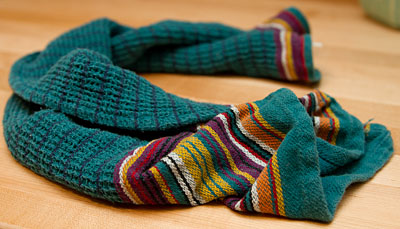
Hi, my name is Edmund, and I’m a family man with a bad case of “what if-ism”. Ever since my son almost drowned and my wife got into a bad accident, I’ve tried to make sure I train and do as much as I can to keep my family safe. That meant wilderness medical training, being a CERT leader, stocking up on emergency supplies, prepping for earthquakes, and revisiting some skills I learnt in the army, where I was a mission specialist. Maybe that’s why I was asked to be a NWGUN.com blogger – to share what I know to help you keep you and yours safe.
Just about anything can be used to protect yourself. Well, almost anything. A leaf might not be of much use in fending off someone intent on doing you harm. But that branch the leaf was on might come in very useful.
A caveat: By no means are we saying that you should abandon all the items that you may have trained with or assembled through the years in the name of personal protection. So, yes, hang on to that collapsible baton, that kubotan, that travel wrench, your knife, and of course, your favorite firearm.
But in the absence of a dedicated defensive tool, you are going to have to improvise. Maybe you are on a flight, or in a country where there is a low tolerance for self-defense weapons. Or perhaps you work in a company or go to a school where there is a strict “no-weapon” policy. Or worse, you may have been abducted (but that is a different article for another day).
Just because you heeded the “no weapon” requirement doesn’t mean that trouble will not find you, and if it does track you down, don’t count on it respecting the same rule.
Verbal Defense:
Before physical force begins, give verbal de-escalation a try. This is something that you will hear from us often.
Given the right circumstances, there is a chance, albeit a slim one, that you may be able to get out of the fight. There is a whole discipline around verbal defense to defuse a potential lethal situation, with specialized training provided to cops and hostage negotiators. In a nutshell, you are seeking to find common ground with your potential adversary from a position of confidence (if not strength), and avoid having to lie to him or her.
But the real reason for talking is that it may buy you some time to assess the danger, spot the best exits to use, and decide how best to fight your way to it. The words you use should be something you practice as a cue to launching your defensive strategy, something that helps you beat down the impending panic. And yes, you can count on our body wanting to panic – that’s your fight, flight or freeze response kicking in.
You can’t help that, but you can manage it by having a plan, and having a cue to force yourself out of the freeze, identify the path to safety, and fight your way there. And preferably, you have improvised a defensive tool to aid you.
Improvised Defensive Tools (IDT)
A good IDT is one that:
- Can be carried even on restricted places, like schools, Federal buildings, theme parks, and on planes;
- Does not look like a protective device to a potential bad guy when you are still trying to verbally de-escalate the situation; and,
- Requires no or minimal time and effort to be deployed.
Here are a few that we train with:
Dishtowel: One of the IDTs that Ian (a defensive tactics instructor and co-author of this post) used often in his previous jobs running security in Seattle clubs was the humble dishtowel. No one thinks twice about it in a club, but in the blink of an eye, it can be used to block and trap a blow, bind an attacker’s hands, or even as a crude garrote. Drop something weighty in it, such as a watch or phone, and you have a flail. But it doesn’t have to be a dishtowel. How about a scarf? Perhaps a bandana? Getting the picture yet? The downside is that you’ll need some training and a lot of practice to get good at this, so maybe it’s not for every one.

Cellphone in a Tough Case: As for Edmund, the item that he trains most with is, believe it or not, a cellphone encased in an extra tough shell. A phone is not the best protection tool, but almost everyone has one, and with the right case, those corners can really hurt (disclaimer, it will hurt your hand too when you hit with it, but not as much as it will your attacker). Plus, it totally fits in with Edmund’ modus operandi – which goes something like “ok please don’t hurt me, here take my phone” followed by sharp hits to the eyes, throat, or other vulnerable spots, and then the use of force is escalated as dictated by the situation.
There are lots of other things that can become IDTs. For instance:
Walking Cane: This is one of the most perfect incognito defensive implements, especially for an older person, or for someone who can fake a good limp. The many ways it can be used to surprise, block or incapacitate an assailant are simply impressive. And it doesn’t even have to be a walking cane. It could be an umbrella, or a broken broomstick. We highly recommend Kelly Worden’s Defensive Walking Stick, available on Amazon, if this is something that you want to learn in just an hour or so. It’s easier to pick up than a dishtowel, and easier to retain too.
Bottled Water/Cup of Hot Coffee: This is mostly a distraction to allow you to deliver your first strikes, but that steaming hot cup of Joe has the added advantage of scalding the other guy.

Food Tray: Any items on it can be launched as a distraction, while the tray itself can be used to block and parry or to smash down on your assailant repeatedly. With practice, the edged sides can also be enlisted against his face.
Pen/Toothbrush: A sturdy pen or toothbrush can be a very useful tool to jab at an attacker. Target selection is key here, so pick vulnerable spots like the eyes, temples, or throat. Some folks practice sticking the pen up the other guy’s nostril or as leverage to apply added pressure to the ears or fingers, but these techniques are more about compliance than protecting yourself.

Rolled Magazine: You might have seen Matt Damon’s Jason Bourne character use this technique with deadly effect. It does work, but perhaps not quite with the same impact like in the movies. A rolled magazine can nevertheless be used with similar jabbing techniques as with a pen, but can also be swung like a short baton.
Chair: Chairs can be kicked in front of an advancing attacker to disrupt their assault while you deliver your own blows (perhaps with a walking stick?). It can also be held to deal with and possibly disarm an attacker with a knife.
No matter what IDT you are considering, it will be in vain if you do not practice getting to it and then, hitting with it effectively. It would also be quite pointless if you do not have good situational awareness. For instance, if like Edmund, your cellphone is your preferred IDT, but you choose to walk around absorbed with texting and tweeting with it, then what’s the point?
We’ve only begun to scratch the surface here. With some pre-planning and imagination, you do not have to be caught empty-handed in a potentially violent situation.
So, gather your wits about you, stay alert, and improvise!
Edmund Tee and Ian Allen are instructors in a close quarter combat group called Bullet & Blade that combines unarmed defensive tactics with close quarter shooting.
Text Copyright 2012 Edmund Tee – Used with permission, Photos by Gavin Gear

Speaking of pen defense, what are your opinions on the ‘tactical’ pen offering? Just got an email from Botach this morning about this pen: http://www.botachtactical.com/kzstprtapen.html
Great tips. I take Kempo karate and we work with towels and belts quite often as defensive weapons – great tools!
@Jeremy: I think the pen looks great – I actually think the BIC pen in the photo would NOT make as great a tool because I’ve managed to split/break a few when I was still experimenting. The tactical pens are far stronger of course – but might be on TSA’s watch list. Have you considered a flashlight?
If you are serious about defending yourself with coffee, this is a great product 🙂
http://gizmodo.com/5888057/incredibly-badass-tactical-mug-lets-you-strap-on-spec-ops-gun-attachments-while-you-drink